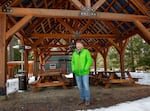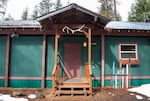
Mt. Adams Institute Executive Director Aaron Stanton on March 20, 2025.
Erik Neumann / OPB
Aaron Stanton stood in the doublewide trailer that serves as the office for the Mt. Adams Institute in Trout Lake, Washington, population 672. Along one wall were rows of photographs, each with the smiling face of an intern from past summers.
Normally, about 60 new people would be arriving this time of year. But this summer will be very different.
“It will just look like this bottom row that doesn’t have anything on it,” Stanton said. “There just will be nobody.”
Stanton is the executive director of the Mt. Adams Institute. The nonprofit contracts with agencies like the U.S. Forest Service, the National Ocean and Atmospheric Administration and the National Park Service to create career development internships. Interns might be recreation technicians in the Tongass National Forest in Sitka, Alaska, or work on salmon recovery with NOAA in Portland.
“Anything that the agencies or organizations do, we can find somebody to help support their work,” Stanton said.
But the Mt. Adams Institute is in trouble. About 95% of its operating budget comes from contracts with those federal agencies, where in recent months officials with the Elon Musk-led Department of Government Efficiency have frozen funding and laid off thousands of public employees. The Mt. Adams Institute now faces its own budget shortfall and sudden layoffs. Its plight is just one of many examples of how sweeping federal cutbacks are rippling through nonprofit organizations that do everything from trail maintenance to multimillion dollar salmon restoration projects.
“I think the first thing that hikers are going to notice is locked bathrooms and no trash cans,” said Kindra Ramos, chief program officer at Washington Trails Association.
WTA coordinates roughly 4,000 volunteers each year to do trail work across the state. Last year it received about $800,000 in trail maintenance contracts from the Forest Service. But much of the nonprofit’s Forest Service funding is now frozen.
Ramos wondered who will step in to get human waste out of remote mountain lake areas in the Cascades this summer.
“Finding a volunteer to helicopter poop out of the Enchantments, that’s not something that’s going to happen,” she said.
It’s the same story at other Pacific Northwest nonprofits like Trailkeepers of Oregon, the Northwest Youth Corps and Pinchot Partners, a forest collaborative that works to create partnerships between conservation groups, tribes and the timber industry on the Gifford Pinchot National Forest in Washington.

A building at the Mt. Adams Institute in Trout Lake, WA on March 20, 2025.
Erik Neumann / OPB
Even before the cuts from the Trump administration, Ramos said nonprofits were already backfilling for federal agencies like the Forest Service, which has been underfunded for decades.
“I think you’re going to start seeing the need for more volunteerism. And is that there? I don’t think it is. And so that’s what scares me,” said state Rep. Kevin Waters, R-Stevenson.
Waters represents several Washington counties east of Vancouver on the Columbia River Gorge. His biggest worry is additional cuts affecting wildfire prevention in the Gifford Pinchot National Forest.
“I’m told there’s six people that work up at the [Gifford Pinchot] full time. It used to be 300. So, we’ve already seen such a dramatic decrease,” he said.
Waters said state agencies won’t be able to provide much help. Washington is currently trying to climb out of a projected $12 billion deficit, and the federal cuts relate to lands managed by the U.S. government, not the state.
Large multimillion dollar salmon habitat restoration projects are also facing uncertainty.
The Lower Columbia Estuary Partnership has been working for a decade on a project to restore a three-mile section of the East Fork Lewis River near Ridgefield, Washington.
About a third of the $23 million project relies on federal funds, which will largely be used to hire local contractors.
“All of these people are looking at this project to support their incomes, their salaries to pay their workers,” said the nonprofit’s Jasmine Zimmer-Stucky.
The contracted firms, engineers and forestry companies had questions for her as the news came out about the federal government reversing course on some past funding agreements.
“It was a really challenging time for us, both to be trying to advance a project with partners and also have that really scary moment of, ‘Are we going to scale back? How are we going to make this work if those federal dollars aren’t available?‘” she said.
She said it appears the money is still on track and the partnership is still expecting to break ground in May.

Mt. Adams Institute Executive Director Aaron Stanton enters a storage building at their facility.
Erik Neumann / OPB
The situation is more dire for the Mt. Adams Institute. Stanton has already cut back staff by 60%. The work done by the institute and other conservation nonprofits won’t just be replaced by the for-profit sector, he said.
“There are programs that do a lot of things that our communities need, that you can’t monetize,” he said. “People don’t make money at it. If those things don’t get done, if they’re not funded, if there’s no federal support for them, they won’t be viable.”
The Mt. Adams Institute has enough cash reserves to stay afloat for about a year. Stanton said he hopes that will give them enough time to develop new programs that don’t rely on federal partnerships.
